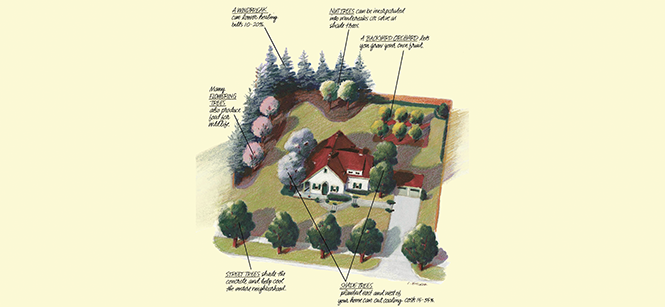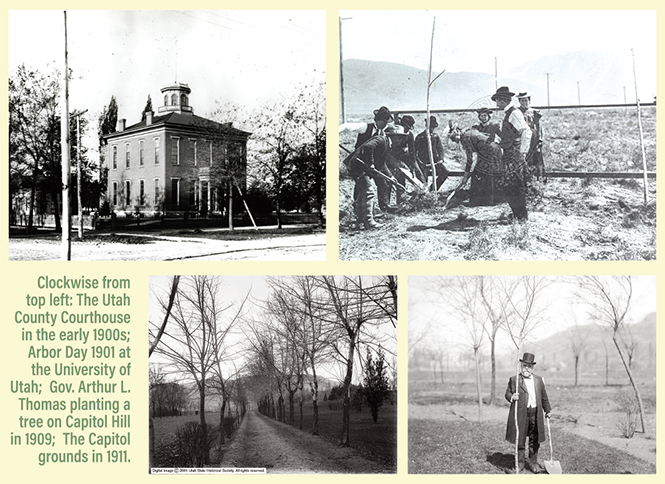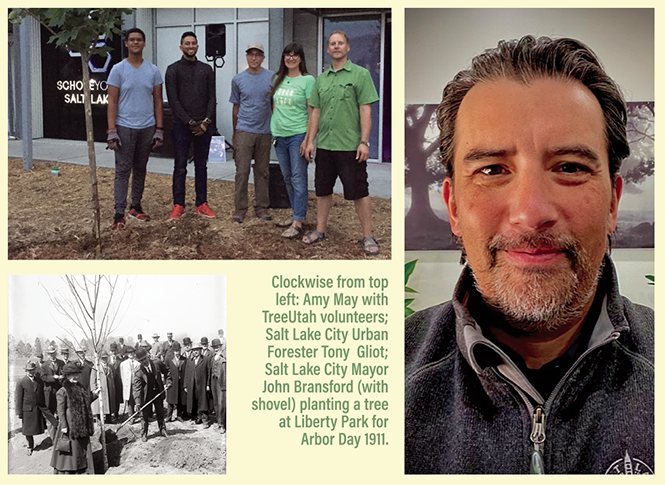Salt Lake's modern tree canopy is a living legacy of the peoples of Utah.
Life in the Slow Lane
By Wes Long"I think that I shall never see, a poem as lovely as a tree," wrote Joyce Kilmer (1886-1918).
Kilmer's own 1913 poem, set to Oscar Rasbach's music, likely strikes a familiar chord to Utahns of a certain age, who sang it with their contemporaries for Arbor Day celebrations across the country in the mid-20th century. Extolling the divine beauty of trees, the musical exercise reminded participants that regardless of the season, nature's emerald groves possessed qualities that we could scarcely hope to approximate by our own wit and artifice.
In fact, as German forester Peter Wohlleben has argued, trees are sentient beings that live life in the "slow lane," pursuing their own objectives and living interdependently with one another wherever they can. Such plants, Wohlleben emphasized in The Hidden Life of Trees, ought to be allowed to "fulfill their social needs, to grow in a true forest environment on undisturbed ground, and to pass their knowledge on to the next generation."
That ideal has centuries-old roots in communities all around the world—and Utah is no exception. But like an actual plant's vascular system, the nourishing lines of this generational knowledge can be pruned away through carelessness and ignorance. The lessons that Utahns once traditionally celebrated—even in their cities—can be lost amidst a rapacious culture of taking more than we actually require from our ecosystem.
Looking ahead to this year's Arbor Day on April 26, it is hoped that this effort to shed light on Utah's early tree-planting efforts may cultivate your own tree ethic to sprout with greater—yes, even poetic—splendor.
Taking Root
For thousands of years, Native Americans lived across the region later to be known as Utah, altering the environment to suit their needs as they hunted, gathered and associated.
"The rise of agriculture and irrigation allowed the Anasazi and Fremont cultures to thrive," historian Sara Dant contextualized in a 2019 volume of essays, "while the Utes and Paiutes encountered by the Mormons used fire for hunting and to promote open grasslands enticing to game."
The open pastoral lands and streams enticed incoming settlers as well, but trees were relatively scarce along the Wasatch Front at the time—sagebrush and sunflowers were the more common vegetation around the valley.
For the arriving Mormon settlers—who, like the local Native cultures, often fused the material with the spiritual—this new home held great potential for collective survival as well as in demonstrating respect for the divine. Consequently, such activities as land distribution, irrigation and timber use were shared endeavors of supervised stewards utilizing public resources that could neither be owned nor monopolized.
"In their new Promised Land, the church was omnipresent, and it placed a strong emphasis on cooperation, community and environmental stewardship," Dant wrote.
Trees began to increase as city ordinances mandated street lots to be populated with various kinds of softwoods. Bringing seeds, grains and tree cuttings with them on their westward journeys, the early Mormons introduced many new species into the area and began what would in future years be important local green spaces.
Phoebe Young (1830-1901), in an undated recollection, described her husband Phineas' (1799-1879) interest in covering Salt Lake City with shade trees and of his agreement with his brother Brigham Young (1801-1877) to furnish the venture. "There were locust trees around Temple Block and some but very few in different parts of the city," she recalled. "With money scarce, the idea came to offer local boys a cup of sugar or honey for a cup of locust seed."
News spread fast, and soon local children of all ages had gathered a bushel of seeds in exchange for some flour and "something sweet." The genesis of what would be known as Liberty Park had begun in earnest.
This is not to say that the Latter-day Saints—as with those who came before and after them—consistently practiced what they preached or left a uniformly positive environmental impact.
In an accompanying essay to Dant's, historian Thomas Alexander told of local loggers who cut enormous swathes through accessible stands, ignoring their own religious environmental teachings and leaving easily-harvested timber in short supply. "In one venture in Little Cottonwood Canyon," Alexander reported, "a speculator cut one million board feet of timber. Unable to sell the logs, he simply left them to rot on the ground."
These sorts of habits worsened as the earlier Mormon ethic on the sanctity of environmental life faded from prominence with the death of Brigham Young. Along with their neighbors, the Mormons became more and more intertwined with the national market economy—maximization of profit became the shared watchword. As the 19th century neared its close, overgrazing and overcutting along the Wasatch Front had become rampant and deteriorated mountain watersheds were sending water, soil and avalanches into the towns below.
A similar state of affairs was in fact taking place across the nation by the 1880s, leading to the creation of a national forest reserve system.
"Nothing is more certain than that, as the years roll on," the Scientific American lamented in 1889, "our children and our children's children will look upon our wastefulness in the manner of tree destruction and our improvidence in providing for new growth to take the place of trees destroyed as among the reckless and wanton follies of the present generation."
Planting Hope
Begun in Nebraska in 1872 and celebrated shortly thereafter by Iowa, Arbor Day was—even at that early date—noted with approbation among Utah newspapers.
"There is beauty for the eye, moisture for the earth and wealth for the commonwealth in such planting," remarked the editors of the Woman's Exponent, "and the example of those two states should be emulated by other communities of the West."
By 1890, however, Arbor Day had still not fully taken root in Utah Territory, much to the dismay of then-Gov. Arthur Thomas (1851-1924). "In this arid region, the value of trees cannot be overestimated, and their planting should be encouraged," Thomas said to the Territorial Legislative Assembly. "I think the people would welcome the Arbor Day."
The assembly, however, failed to act on Thomas' recommendation, to the annoyance of the Logan Journal. On top of traditional uses for survival, trees—as the paper asserted in August of 1890—"raise the man out of the sphere of the mere money or bread grubber and recognize him as one who makes for beauty." The unnamed writer hoped to see "our broad acres dotted with these trees bearing green and shady boughs, with their fresh odor and faces in the spring, and their glorified tints in the frosty days of autumn."
They would not have to wait for very long, thanks to some determined teachers in Utah County.
During their spring meeting at the old Central Schoolhouse in Provo, the Utah County Teachers' Association discussed a number of items for the coming year, one of which being, on the suggestion of Superintendent Ervin A. Wilson (1856-1904), the enactment of Arbor Day exercises. With a favorable response from his colleagues, they set the date for April 10, 1891. Lauded in the press, the planned Arbor Day events were hailed as a boost for Utah's schoolchildren, providing overdue beautification to their barren playgrounds and shadeless sidewalks.
On the morning of the appointed day, the Provo Daily Enquirer later reported, 800 children from the surrounding schools, along with spectators, marched to the Provo Courthouse square. Wearing bouquets of red and white—emblems of Provo free school education—each participant carried wands in their hands so as to keep the procession evenly measured as the clank of spades and shovels provided their rhythm. Some of the students held aloft a banner that read on one side, "Arbor Day: He Who Plants a Tree Plants Hope," and on the other, "Arbor Day: She Who Plants a Tree Plants Hope."
Arriving at their destination, the half-mile parade performed calisthenics and sang songs before being shooed away from the premises (court was in session, after all). Returning to their respective schoolhouses, the varied assemblages engaged in songs, games, recitations and planting ceremonies for more than 800 trees.
They commemorated trees to philosophers like Socrates, writers like William Shakespeare and Harriet Beecher Stowe, politicians like Abraham Lincoln and Mamie Wilkins, performers like Emma Abbott, religious figures like Brigham Young, reformers like Eliza Cook, and events like the signing of the Treaty of Shackamaxon, among but a few examples. Similar exercises were held in Payson, Heber and Pleasant Grove.
"On the whole, Arbor Day was celebrated in a thoroughly becoming manner," the Provo Dispatch concluded, although some teachers lamented that more parents weren't present for the occasion. The event was the first of its kind in the territory, and more was still to come.
Growing to New Heights
By the start of the 1892 legislative session, Governor Thomas renewed his call for Utah to designate an Arbor Day of its own, decrying the "rapidly disappearing" forests around them. David Evans, Jr. (1852-1923), then a legislator from Ogden, took up the challenge and submitted an act to establish Arbor Day as an official holiday for every first Saturday in April. The act was passed, along with another territorial addition: Labor Day.
Issuing a proclamation that March, Gov. Thomas marked April 2, 1892, as a time to be observed for "the planting of trees and shrubs in private and public places," according to contemporary reporting in the Deseret Evening News.
The stormy weather that year put a damper on the festivities, but in the years that followed, Arbor Day became a regular time for city beautification and clean-up efforts, championed by groups like the Utah Forestry Association and other civic-minded individuals. Planting trees at schools and universities, in local parks, and especially along "Governor's Row" atop Capitol Hill all became annual state traditions.
But by the 1950s, the grove of trees on Capitol Hill had been cleared away to make room for the Capitol building, schools and businesses no longer closed for Arbor Day and local garden clubs provided the main impetus for arboreal efforts. What's more, many of the trees that had been so assiduously planted prior to statehood were disappearing.
"As we ride about the countryside, we see fewer and fewer of these early giants gracing the landscape," Salt Lake City Shade Tree Commission founder Helen C. Wells—whose papers are archived at the University of Utah—observed in 1954. Acknowledging that some pioneering plants were softwoods and consequently short-lived, Wells was nevertheless disgusted that "we have permitted business expansion to eliminate the trees."
Later laws re-affixed Arbor Day to the end of April and such governors as George Clyde (1898-1972) and Calvin Rampton (1913-2007) introduced initiatives like Tree Week and holding a million plantings statewide. The work of tree planting and education, however, generally fell upon municipal forestry divisions and local nonprofits, as it does to this day.
TreeUtah executive director Amy May, for instance, takes pride in her organization's efforts of serving as a "matchmaker on behalf of trees," working throughout the state to pair groups and individuals with a tree that will suit their elevation, wind conditions and soil types. One particular initiative that May's organization has undertaken is working in areas that have been historically underserved, low-income and apt to experience urban heat islands.
"Utah has some of the toughest conditions for trees," May observed, noting that flooding, excessive heat and harsh cold are all ongoing factors from year to year. Planting for success is paramount in Utah's salty and clay-like soils, but what trees give back in terms of cleaning air, cooling cities and creating positive experiences for mental, social and ecological health cannot be overstated.
"Trees do a lot more for us than we realize," May added. "We take them for granted."
In urban forests especially—where trees are unnaturally prevented from commingling with one another while boxed into a hardscape—it is all too easy to overlook what an effort trees make to survive in the modern city. As Salt Lake City Urban Forestry Division director Tony Gliot points out, however, "trees are amazingly resilient organisms, and we're very fortunate that that is the case."
Competing for space among a city's other infrastructure needs, urban trees experience unique challenges apart from those of a natural forest and, consequently, require additional considerations.
Gliot notes that our trees do rather well "in spite of Salt Lake City being a location that does not really grow trees naturally," and he credits our legacy forest to the "generations and generations of Salt Lakers" who planted and conscientiously cared for our canopy.
Amazingly, well over 200 species from all over the world are growing here, but they do require responsible watering and attention.
"In our climate, without care from people, our trees will not survive," Gliot stressed.
Attributing Salt Lake City Mayor Erin Mendenhall's "Keep Your Cool" initiative to be a particular boon—with thousands of trees going into the ground every year—Gliot argued most of all that the "infectious, tree-loving spirit" of yesteryear is still alive among everyday Salt Lakers.
As Salt Lake City gets larger, drier, hotter and increasingly threatened by climate change and the toxins from a receding Great Salt Lake, the cleansing, cooling influence of the verdant spires about us may prove to be our godsend, as City Weekly reported in a 2022 cover story. Bequeathed to us from countless people before our time, our trees embody the wisdom of that old Greek proverb: "A society grows great when old men plant trees in whose shade they know they shall never sit."
Not yet fully matured, time will tell if a sapling city like our own still possesses a similar degree of foresight.
Arbor Day Activities
reeUtah hosts multiple plantings per week, and many are open to the public (especially on Saturdays). Go to treeutah.org for weekly updates on new opportunities. Advance sign-ups will be available for the following planting events:
April 22: Earth Day celebration Regional Athletic Complex, 2280 Rose Park Lane, SLC, 9 a.m.-noon
April 24: Oquirrh Park 5624 Cougar Lane, Kearns, 9 a.m.-noon
April 30: 9-Line Orchard planting/ribbon cutting 932 S. 1100 West, Salt Lake City, 1 p.m.-4 p.m.
May 11: Fitts Park 3050 S. 500 East, South Salt Lake, 9 a.m.-noon
More by Wes Long
-
40 Years of City Weekly—Volume 36: 2019 to 2020
City Weekly Rewind
- Apr 24, 2024
-
40 Years of City Weekly—Volume 35: 2018 to 2019
City Weekly Rewind
- Apr 17, 2024
-
40 Years of City Weekly—Volume 34: 2017 to 2018
City Weekly Rewind
- Apr 10, 2024
- More »
Latest in Cover Story
Readers also liked…
-
Forget the family pedigree—Robert F. Kennedy Jr should not be the next president of the United States
Trojan Horse
- Jun 21, 2023
-
Women decry harassment and toxic culture at St. George auto dealership
Men at Work
- Oct 11, 2023







